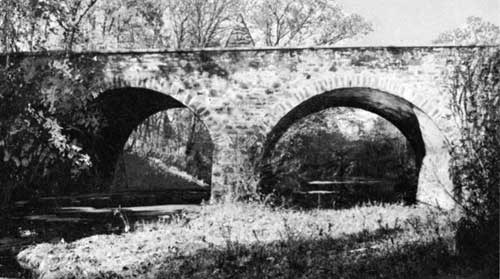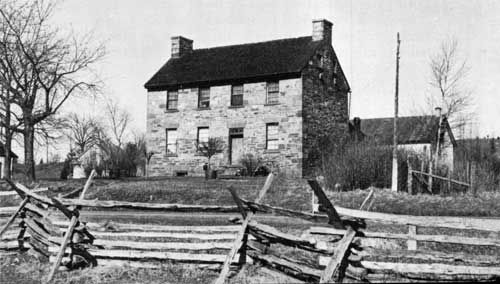|
MANASSAS National Battlefield Park |
 |
Guide to the Area
2. ROBINSON HOUSE. About 800 yards northeast of the Visitor Center, on a projecting spur, stands the Robinson House on the site of the war time structure owned by the free Negro, James Robinson. No part of the present house is original, though a section of it dates to about 1888. The original house was torn down in 1926 to permit the construction of the larger portion of the present structure. Suffering little damage in the first battle, the original house and fields were sacked by Sigel's Federal troops in the second battle. For these damages Robinson was awarded $1,249 by Congress in a Private Act of March 3, 1873. A picturesque view unfolds from this point eastward across Bull Run and westward to the mountains.

The Stone Bridge as it now appears.
3. STONE BRIDGE. The Stone Bridge and the stream, Bull Run, that flows beneath it are inseparably linked with the story of the two battles of Manassas. Located on the Warrenton Turnpike, approximately 1/2 miles east of its intersection with the Manassas-Sudley Road, it formed, during the first battle, the anchor of the Confederate left and the objective of the Federal diversion under Tyler. Following the rout of Mcdowell's forces, it constituted one of the main avenues of escape. In the second battle, it was the main route of the Federal advance and retreat. Though the bridge was destroyed a number of times, the abutments are original. The present Lee Highway bridge crosses Bull Run about 100 feet south of the old structure which is now memorialized by the State of Virginia.

The Stone House.
4. STONE HOUSE (MATTHEWS). Built in the early part of the nineteenth century, this two-and-one-half story structure of reddish brown native stone, stands as the best preserved and most conspicuous landmark on the two battlefields. It is located on the north side of Lee Highway, near its junction with the Manassas-Sudley Road. Here the tides of battle twice engulfed it as it served alternately as a hospital for the wounded of each side. Shells may still be seen embedded in its walls. For a number of years after the war it was operated as a tavern.

|

|
|
Last Modified: Sat, Apr 7 2001 10:00:00 am PDT |


